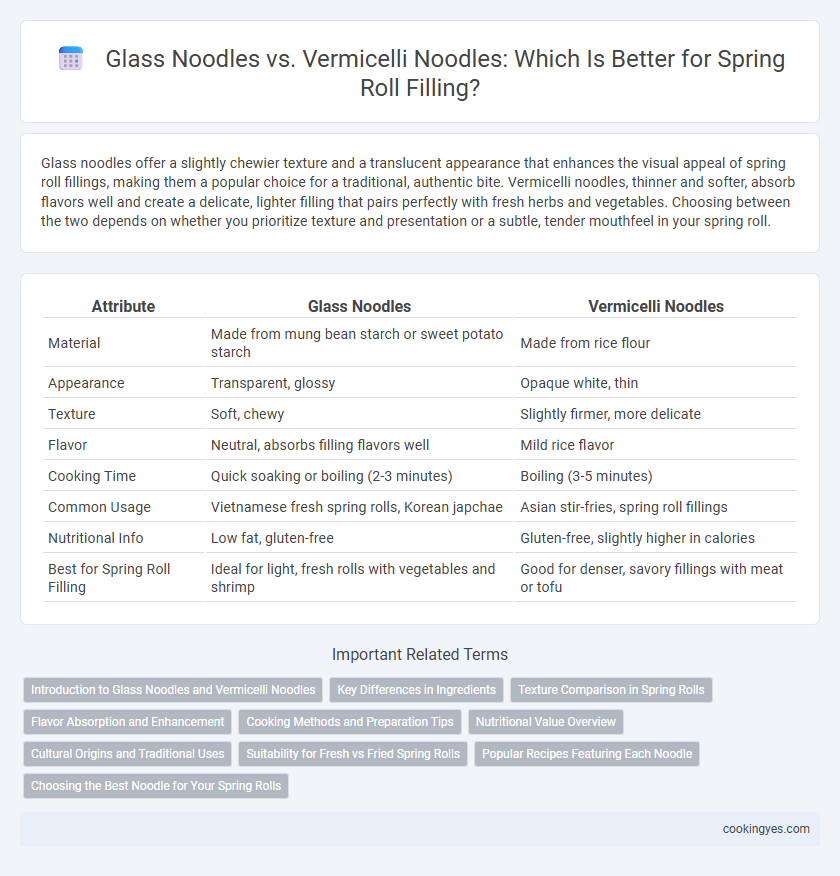Glass noodles offer a slightly chewier texture and a translucent appearance that enhances the visual appeal of spring roll fillings, making them a popular choice for a traditional, authentic bite. Vermicelli noodles, thinner and softer, absorb flavors well and create a delicate, lighter filling that pairs perfectly with fresh herbs and vegetables. Choosing between the two depends on whether you prioritize texture and presentation or a subtle, tender mouthfeel in your spring roll.
Table of Comparison
| Attribute | Glass Noodles | Vermicelli Noodles |
|---|---|---|
| Material | Made from mung bean starch or sweet potato starch | Made from rice flour |
| Appearance | Transparent, glossy | Opaque white, thin |
| Texture | Soft, chewy | Slightly firmer, more delicate |
| Flavor | Neutral, absorbs filling flavors well | Mild rice flavor |
| Cooking Time | Quick soaking or boiling (2-3 minutes) | Boiling (3-5 minutes) |
| Common Usage | Vietnamese fresh spring rolls, Korean japchae | Asian stir-fries, spring roll fillings |
| Nutritional Info | Low fat, gluten-free | Gluten-free, slightly higher in calories |
| Best for Spring Roll Filling | Ideal for light, fresh rolls with vegetables and shrimp | Good for denser, savory fillings with meat or tofu |
Introduction to Glass Noodles and Vermicelli Noodles
Glass noodles, made from mung bean starch, are translucent and have a slightly chewy texture that absorbs flavors well in spring roll filling. Vermicelli noodles, typically made from rice flour, are thin, white, and soft, providing a light and delicate texture to balance other ingredients. Both noodles offer unique textures and are essential for achieving authentic spring roll fillings tailored to different culinary preferences.
Key Differences in Ingredients
Glass noodles are typically made from mung bean starch or sweet potato starch, offering a translucent and chewy texture ideal for spring roll fillings. Vermicelli noodles are usually composed of rice flour and water, resulting in a thinner, more delicate noodle that absorbs flavors differently. The distinct base ingredients influence cooking times, texture, and compatibility with various spring roll vegetables and proteins.
Texture Comparison in Spring Rolls
Glass noodles offer a chewy and translucent texture that holds up well in spring rolls, providing a slightly bouncy bite. Vermicelli noodles tend to be softer and more delicate, absorbing flavors seamlessly but risking sogginess if over-soaked. The choice between glass noodles and vermicelli directly influences the spring roll's overall mouthfeel, with glass noodles delivering firmness and vermicelli offering tenderness.
Flavor Absorption and Enhancement
Glass noodles excel in flavor absorption due to their translucent, gel-like texture that soaks up sauces and spices, enhancing the overall taste of spring roll fillings. Vermicelli noodles, thinner and firmer, provide a subtle base that maintains a slight bite, allowing other ingredients' flavors to shine without overwhelming the palate. Choosing glass noodles intensifies the filling's savory notes, while vermicelli noodles offer a balanced, delicate complement to fresh herbs and proteins.
Cooking Methods and Preparation Tips
Glass noodles, made from mung bean starch, become translucent and slightly chewy when soaked in hot water, making them ideal for spring roll fillings that require a delicate texture. Vermicelli noodles, typically rice-based, soften quickly and offer a tender consistency after brief boiling, which is preferred for balancing moisture in the filling. To ensure optimal texture, soak glass noodles in hot water for 5-7 minutes and drain thoroughly, while boiling vermicelli noodles for 2-3 minutes followed by cold water rinsing prevents overcooking and clumping.
Nutritional Value Overview
Glass noodles and vermicelli noodles both serve as popular options for spring roll fillings, but they differ significantly in nutritional profiles. Glass noodles, made from mung bean starch, are typically lower in calories and carbohydrates while providing a gluten-free option rich in iron. Vermicelli noodles, usually rice-based, contain higher carbohydrate content and provide modest amounts of protein and B vitamins, making them slightly more energy-dense for spring roll fillings.
Cultural Origins and Traditional Uses
Glass noodles, traditionally made from mung bean starch, are favored in East Asian spring roll fillings, especially in Chinese and Korean cuisines, where their translucent texture and chewy bite complement vegetable and meat mixes. Vermicelli noodles, typically made from rice flour, are prominent in Southeast Asian dishes like Vietnamese and Thai spring rolls, providing a delicate, slightly chewy consistency that absorbs flavors well. Both noodles reflect their cultural origins, with glass noodles linked to Chinese culinary traditions emphasizing texture contrast, while vermicelli represents Southeast Asian preferences for lightness and subtlety in spring roll fillings.
Suitability for Fresh vs Fried Spring Rolls
Glass noodles offer a translucent, chewy texture ideal for fresh spring rolls, enhancing their light and refreshing quality without overpowering other ingredients. Vermicelli noodles, being slightly stiffer and less slippery, maintain structure better when fried, making them more suitable for crispy spring roll fillings. Selecting between glass noodles and vermicelli depends on whether the spring roll is intended to be fresh and delicate or fried and crunchy.
Popular Recipes Featuring Each Noodle
Popular spring roll recipes using glass noodles often highlight their chewy texture and translucent appearance, such as Vietnamese fresh spring rolls with shrimp and herbs. Vermicelli noodles, favored for their delicate, thin strands and faster cooking time, are commonly featured in Thai-style fried spring rolls with ground pork and vegetables. Both noodle types enhance the filling's flavor profile, but glass noodles provide a more substantial bite, while vermicelli noodles offer a lighter, softer consistency.
Choosing the Best Noodle for Your Spring Rolls
Glass noodles, made from mung bean starch, offer a translucent appearance and chewy texture that complements fresh spring rolls, absorbing flavors without overpowering other ingredients. Vermicelli noodles, typically rice-based, are thinner and softer, providing a mild taste and lighter mouthfeel ideal for delicate or cold spring roll recipes. Selecting the best noodle depends on desired texture and presentation, with glass noodles favored for their elasticity and vermicelli for subtlety and ease of preparation.
Glass noodles vs Vermicelli noodles for spring roll filling Infographic

 cookingyes.com
cookingyes.com